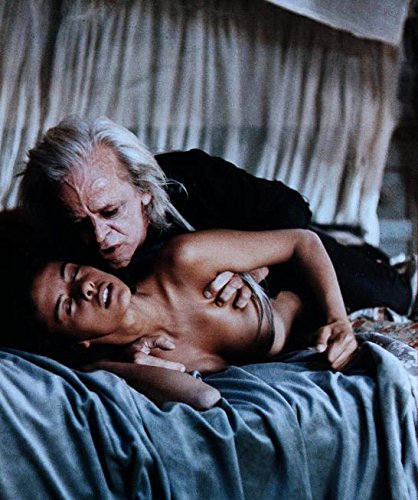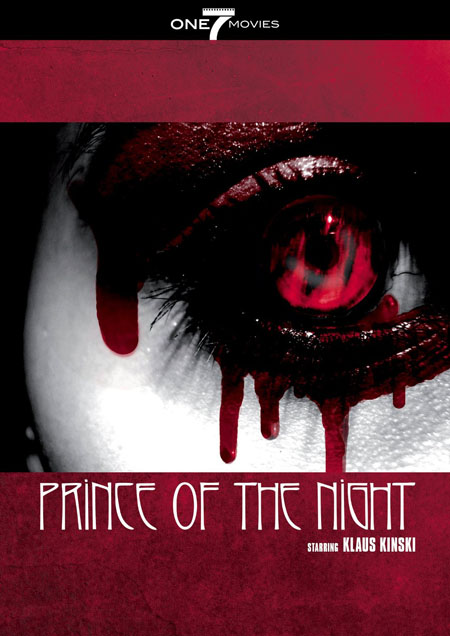ONE7MOVIES RESURRECTS OLD KINKSKI VAMPIRE FLICK: Flawed Italian film is occasionally brilliant...
by Don Stradley
There is a frightening scene in “Prince of The Night” when Klaus Kinski chases a woman through the streets of Venice. She runs into an empty building, but like a jungle cat bringing down an impala, Kinski catches her and smashes her to the stone floor. Actresses Barbara De Rossi and Elvire Audray complained that Kinski was too rough on them during the making of this 1988 Italian production, but when Kinski is hired to play Nosferatu, a creature “belched forth by the Devil,” one can’t expect the off-screen neck nibbles of Bela Lugosi. As he did throughout his hellacious career, Kinski played the role with an utter lack of restraint. De Rossi and Audray were lucky he didn’t actually tear open their jugulars.
It turns out that Kinski’s untamed acting had a payoff. As we can see in the recently released DVD from One 7 Movies, Kinski outshines the rest of the cast, including such gallant journeymen as Christopher Plummer and Donald Pleasence. If a few actresses got scuffed up along the way, so be it.
The cast should have known what to expect when, on his first day of shooting, Kinski and director Mario Caiano got into a violent argument. Part of the beef was that Kinski was reprising his character from Werner Herzog’s 1979 picture “Nosferatu the Vampyre” and was supposed to wear the same bald head, and corpse-white makeup. However, the petulant Kinski arrived on the set wearing long hair and asserting that he had no intention of enduring another painful make-up sessions. This is why Nosferatu of the 1988 film looks like Aguirre and nothing like the original character from the Herzog movie (or for that matter, the F.W. Murnau silent film). Kinski’s only nod to tradition was that he wore the same rodent teeth he’d worn for Herzog.
Waylaid by Kinski’s bellicose attitude, Caiano left the production after being paid his full salary. Caiano’s departure wasn’t a surprise, since the film had already been through several personnel changes. Producer Augusto Caminito had already hired and fired directors Maurizio Lucidi and Pasquale Squitieri before hiring Caiano. When Kinski forced Caiano off the set, Caminito decided to direct the film himself. Since Caminito had little directing experience, he enlisted the help of Luigi Cozzi, a veteran of many Italian horror films (as well as the Lou Ferrigno “Hercules” of 1983). Not surprisingly, even Kinski is alleged to have directed a few scenes.
Somehow, this debacle of a production yielded a highly watchable movie (originally titled “Vampire In Venice”). I imagine some of the credit must go to cinematographer Tonino Nardi, who lovingly feeds us one eye-popping scene after another. It’s as if Nardi knew, while chaos swirled all around him, that all one needed to make this vampire movie was Kinski, a few beautiful women, and the gorgeous scenery of Venice. One can almost turn the sound off, ignore the rickety plot, and simply enjoy the movie for its visual delights.
The movie is supposed to take place in 1780s Venice, a time of plagues and death. The streets are a weird mix of the morbid and the frivolous. You’re as likely to step over a corpse as to be pestered by a dancing harlequin. Yet, one of my favorite moments is when an extra steering a gondola is not in period costume, but is instead wearing a denim jacket and tight fitting jeans, as if a member of The Doobie Brothers had been somehow teleported into the 18th century. Caminito was probably so sick of reshoots that he hoped no one would notice the gaffe.
 The story, which is credited to four writers, concerns Helietta Canins (Barbara De Rossi) a woman whose family has a long past with vampires. Believing Nosferatu still lurks in the area, she hires a Van Helsing type played by Christopher Plummer to come to her family’s luxurious estate and check things out. There are, after all, a surprising number of vampire bats in the area, and the local gypsy population is riddled with bite marks. Nosferatu eventually makes an appearance and kills a few people, but this is a more melancholy King of the Undead than we’re accustomed to, for Nosferatu seems to want love. He steals away with one of his victims, promising her all sorts of macabre pleasures. “I will be your master,” he says, “and we will be so happy!” She’s into it. It doesn’t say much for the neighborhood men when the local women are going for the guy with rat teeth who lives in a crypt.
The story, which is credited to four writers, concerns Helietta Canins (Barbara De Rossi) a woman whose family has a long past with vampires. Believing Nosferatu still lurks in the area, she hires a Van Helsing type played by Christopher Plummer to come to her family’s luxurious estate and check things out. There are, after all, a surprising number of vampire bats in the area, and the local gypsy population is riddled with bite marks. Nosferatu eventually makes an appearance and kills a few people, but this is a more melancholy King of the Undead than we’re accustomed to, for Nosferatu seems to want love. He steals away with one of his victims, promising her all sorts of macabre pleasures. “I will be your master,” he says, “and we will be so happy!” She’s into it. It doesn’t say much for the neighborhood men when the local women are going for the guy with rat teeth who lives in a crypt.
The women in the movie seem irresistibly drawn to Nosferatu. It must be the hair, though the fact that his oral interest includes much more than a woman’s neck has a predictable effect on the ladies, too. By the movie’s end Nosferatu has become so humanized by the love of a good woman that he’s actually having sex the old fashioned way. The question remains: can Nosferatu get the unholy pipes cleaned before the posse arrives?
I liked “Prince of The Night”. Granted, the story is routine, but Nardi ’s photography borders on fine art. He died a few years after this movie was shot, at age 54. Such a loss!
Then there is Kinski. In an era where vampires seem to have stepped out of third rate romance novels (Fabio with fangs!), one almost forgets that vampires used to be scary. The mighty Kinski shows us here that creatures of the night can still be dangerous, even as they thirst for love. Kinski was well into his 60s at the time of this movie, not far off from his own death by heart attack, but he’s as riveting as ever. It’s as if he realized the movie was a lost cause so he hoisted the entire affair onto his shoulders, telling the crew to forget everything else and follow him, one last time, into the night…

No comments:
Post a Comment